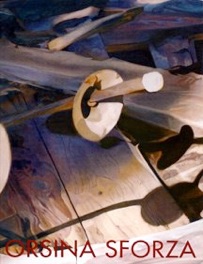In her first solo exhibition in New York, Orsina Sforza focuses on the detritus of urban spaces, observing the decay and transformation of discarded objects and the ensuing ambiguity of their identities.
In 2002, while walking through the Roman neighborhood of Testaccio, Sforza came upon a makeshift garbage dump which had been taken over by a number of homeless people. As she descended towards the adjacent embankment of the Tiber, she observed how, at high tide, the river's waters invaded areas of the dump and rearranged its contents. Fascinated by what she had seen and eager to explore the revelations of this chance discovery, she returned repeatedly to the site, taking photographs of agglomerations that attracted her, as well as details (though the series has little in common with photorealism; the motif, and not the photograph being her subject).
In the paintings the viewer can distinguish chains, garden hoses, a hydrant, and a shoe amidst the dense overgrowth of branches, leaves and rags. Other objects seem to have relinquished all traces of their actual identity. In some cases, time and circumstance conspire to imbue them with a new, albeit fictitious, appearance: a folded and yellowed newspaper metamorphoses into a cornstalk, a green hose slithers, snake-like, into the recesses of a white cloth.
Orsina Sforza is probing the boundaries of dream and reality. Beyond their striking color and astonishing wealth of pictorial incidents, the canvases make us cognizant of the ambiguities of vision and the precariousness of existence.
Orsina Sforza exhibits in Rome—where she lives and works—and in Milan, Bolzano, and London, and is also noted for her set designs for the Teatro Communale of Florence.

